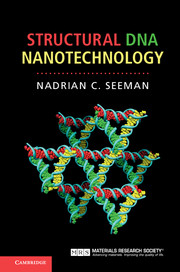Book contents
- Frontmatter
- Contents
- Preface
- 1 The origin of structural DNA nanotechnology
- 2 The design of DNA sequences for branched systems
- 3 Motif design based on reciprocal exchange
- 4 Single-stranded DNA topology and motif design
- 5 Experimental techniques
- 6 A short historical interlude: the search for robust DNA motifs
- 7 Combining DNA motifs into larger multi-component constructs
- 8 DNA nanomechanical devices
- 9 DNA origami and DNA bricks
- 10 Combining structure and motion
- 11 Self-replicating systems
- 12 Computing with DNA
- 13 Not just plain vanilla DNA nanotechnology: other pairings, other backbones
- 14 DNA nanotechnology organizing other materials
- Afterword
- Index
- References
12 - Computing with DNA
Published online by Cambridge University Press: 05 December 2015
- Frontmatter
- Contents
- Preface
- 1 The origin of structural DNA nanotechnology
- 2 The design of DNA sequences for branched systems
- 3 Motif design based on reciprocal exchange
- 4 Single-stranded DNA topology and motif design
- 5 Experimental techniques
- 6 A short historical interlude: the search for robust DNA motifs
- 7 Combining DNA motifs into larger multi-component constructs
- 8 DNA nanomechanical devices
- 9 DNA origami and DNA bricks
- 10 Combining structure and motion
- 11 Self-replicating systems
- 12 Computing with DNA
- 13 Not just plain vanilla DNA nanotechnology: other pairings, other backbones
- 14 DNA nanotechnology organizing other materials
- Afterword
- Index
- References
Summary
Anybody who has reached this point in the book realizes that DNA and its congeners are special molecules because of their ability to encrypt information. We have seen a variety of examples here of how that information can be used to direct the folding of molecules to produce specifically shaped and organized molecular species. Likewise, everybody alive during the twenty-first century is aware that we live in an age of information. The information that we use is usually encrypted in electronic bits, rather than in DNA; nevertheless, some information has already been stored specifically in DNA molecules, as an alternative to electronic or print media. Of course, the key way in which we are exposed to information in our daily lives is through our computers and their variations: pads and smartphones. These circumstances lead one to ask if it might be useful to try doing computation with DNA. There is a large community of investigators who work in the field of molecular computation, and, more than any other, this community has contributed valuable ideas and workers to the field of structural DNA nanotechnology. The treatment of this topic here is only a simplified introduction to a few topics in an elementary form.
DNA in logical computations: the Adleman experiment. The first use of DNA in computation was done by Leonard Adleman. He solved a Hamiltonian path problem using DNA molecules. The problem he solved, as has been the case for much of the computation performed with DNA, was a toy problem, one that could be solved simply in one's head, but which also represented a class of problems that are potentially challenging to traditional computational techniques. The Hamiltonian path problem is related closely to the “traveling salesman” problem, the optimization of a route through a number of cities in a territory. If there are only a few cities, the problem is easy to work out, but the number of solutions becomes enormous if there are many cities. Thus, if there are 10 cities, the number of possible answers is proportional to 10!, or about 11 million, a large but tractable number. However, if there are 100 cities, the number of possible answers is proportional to 100!, which is not a number readily handled by a computer that examines each possibility in turn.
- Type
- Chapter
- Information
- Structural DNA Nanotechnology , pp. 198 - 212Publisher: Cambridge University PressPrint publication year: 2016



